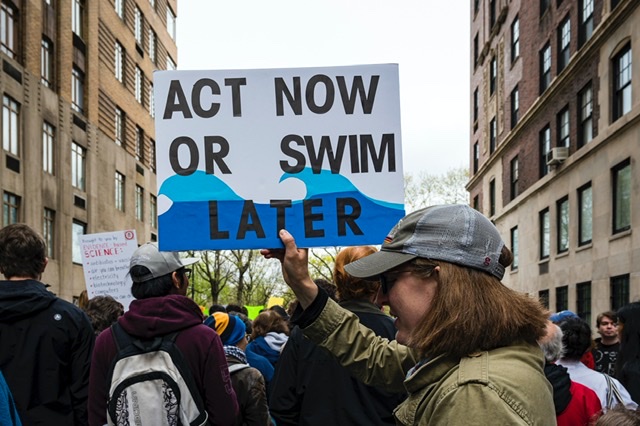Many carbon budgets are based on an under-estimation of warming to date, and the path of future warming. And all such budgets either ignore, or underplay, the loss of carbon from long-term stores — such as the melting of permafrost — which are already active processes.

This week, Prince Charles was the climate radical. Speaking by video link to Climate Week in New York, he said that the focus on 2050 climate targets “suggests we have room to delay” but, on the contrary, “it is absolutely vital, given the enormity of the problem we face, that we make truly transformative progress along the road to net zero by 2030”.
By contrast, when minister Angus Taylor launched his energy roadmap this week, Australia’s not-for-profit climate lobby’s main message was that “the Federal Government is behind the pack in its refusal to commit to a net-zero by 2050 emissions target”.
There was no talk about zero emissions by 2030, or in fact any 2030 goal, which appears to have become a threatened species. Advocates feared they would not be heard if they were “politically unrealistic”, but this is about science, too. And if you talk about 2050 just as most of the world is, you’ll be drowned out anyway, caught somewhere in the middle of the peloton, and certainly not up the front in the 2030 breakaway leaders’ group.
Australian groups that claim leadership on climate action are falling in line with big business lobby groups, mining companies and conservative and Labor state governments. BHP, RioTinto and Shell are all aboard the zero-2050 juggernaut now.
“Carbon budgets” for further greenhouse gas emissions are the bedrock of zero-2050 advocacy. These budgets, often associated with the IPCC and its 2018 special report on 1.5°C, are based on models which do not deal well with some climate elements, such as polar systems. This year Arctic sea-ice fell to the second lowest on record, and researchers say losing the reflective power of Arctic sea ice soon may advance the 2ºC threshold by 25 years.
Many carbon budgets are based on an under-estimation of warming to date, and the path of future warming. And all such budgets either ignore, or underplay, the loss of carbon from long-term stores — such as the melting of permafrost — which are already active processes.
All carbon budgets for 1.5°C, and most for 2°C, do not keep warming below those targets, but overshoot” for a decade or two or three by up to half a degree, before cooling to the target by 2100. That is achieved with huge amounts of bioenergy with carbon capture and storage, a proposed sequestration technology currently not working anywhere at scale other than in the existing oil and gas industry, which is only about storage of vented gases. This is classic moral hazard, and little more than an excuse to pollute now and wave a magic wand down the track.
All such budgets have monumentally unacceptable risks of exceeding the target, for example probabilities of 33% to 50%. That’s a one-in-two, or one-in-three, chance of failure, of charging past the 1.5°C or 2°C target to a hotter place. A carbon budget with a 50% chance of 2°C, for example, has a 10% chance of 4°C or more, which is not a good bet.
Would any climate lobby advocate get on board a plane if there were a one-in-three chance of crashing? Of course not, so why use that logic when the future of human civilisation and all those “special places” are at stake? In 2014, Mike Raupach, then head of CSIRO climate research in Canberra, produced work showing that to have a sensible — say 90% — chance of staying below 2°C, there was no carbon budget left.
There is no risk-management framework anywhere in the modern world — vaccine testing, construction, transport systems, or digital infrastructure — that would accept a 10% chance of failure, or one percent, or even a tenth of one percent.
It is not reasonable to advocate for risks that one would not gamble on in one’s own life.
There is also the equity issue, especially for those focused on climate justice. Let’s assume for a moment there Is a carbon budget for 2°C, even with bad risks. How should that be divided up between nations? There are three choices, the first is that big nations keep on polluting more per person because… well, because they are rich and claim a right to consume more that the other six billion people. That’s what zero-2050 advocacy in Australia assumes.
The second is that the budget be divided equally amongst every person on Earth. Do that, and it soon becomes clear that Australia, in the highest tier of per capita emitters, has no or little carbon budget left: we have already used up our share, or will do so within a handful of years. And the third option is to recognise the historic carbon debt of the rich countries, and allocate a greater per capita amount to low-polluting, developing nations; in this case the budget is long gone.
Scientists tell us that what we do right now, and in the next few years, is what really matters. The Emeritus Director of the Potsdam Institute, Prof. Hans Joachim Schellnhuber, warns that “climate change is now reaching the end-game, where very soon humanity must choose between taking unprecedented action, or accepting that it has been left too late and bear the consequences”.
Australia’s Prof. Will Steffen warns it is a big mistake to think we can “park” the Earth System at any given temperature rise – say 2°C – and expect it to stay there. He is the lead author of a research paper on a “Hothouse Earth” scenario, in which positive feedbacks and their mutual interaction drive the Earth System climate to a point of no return, whereby further warming would become self-sustaining, that is, without further human perturbations. This planetary threshold could exist at a temperature rise as low as 2°C, possibly even in the 1.5°C–2°C range.
Scientists say that the evidence from tipping points alone suggests that “we are in a state of planetary emergency: both the risk and urgency of the situation are acute… If damaging tipping cascades can occur and a global tipping point cannot be ruled out, then this is an existential threat to civilization”.
And they warn that we might already have lost control of whether tipping happens. That risk requires our immediate and undivided attention, because everything is at stake.
The short term matters most. Kicking the can down the road to 2050 is the wrong focus.
David Spratt has been Research Coordinator for the Breakthrough National Centre for Climate Restoration (Melbourne) since 2014. He was co-founder of the Climate Action Centre (2009-2012). He blogs at climatecodered.org on climate science, existential risk, IPCC reticence, the climate emergency and climate movement strategy and communications, and is regular public speaker.

Comments
7 responses to “When climate risks are so high, short term actions matter most”
David Spratt has identified the kernel of the problem which is the action that must be
taken over this decade. Thereafter the reduction in emissions becomes more
difficult year by year as the task becomes progressively greater if not
impossible. Unfortunately governments are generally comfortable with targets
which will not be their responsibility to deliver. Furthermore the necessary
actions undertaken now will be seen as an electoral danger.
It appears that science has little access to, or standing with, government and our
own organizations carry some responsibility for this. In addition we fail to understand
the mindset of the current government in exhibiting an extreme version of the human
failing to sideline threatening issues when they are not in our midst like
Covid-19, or when they are too complex for a particular brain to contemplate.
The profusion of excellent reports from dedicated organizations is having no impact
for most are not read, and when they are read the total parliamentary understanding
of their science is minimal. We urgently need to revise our approach to government
with more subtle and covert education and interaction based on other avenues in
science. The science is indeed frightening to us but we have not conveyed it to
decision makers.
Conflating the COVID-19 pandemic with continuing combustion of hydrocarbons, including coal and gas, is a sneaky way of continuing to emit greenhouse gases – CO2 and methane – into the atmosphere, with disastrous climate consequences..
Since governments and oppositions are no longer listening to what climate science is saying, but instead are governed by economists, bureaucrats and those in climate denial, they refuse to learn that by mid-century and beyond it may be far TOO LATE to reverse the current disastrous greenhouse rise (the fastest since 55 million years ago) and warming trend. The rise of global temperatures on the continents has reached near-1.5C and in the Arctic near-2.3C, manifested by extensive melting of the ice sheets and global fires. Due to amplifying feed backs from land and oceans reduction in emissions is no longer sufficient to arrest these trends, unless combined with massive efforts at CO2 down-draw, requiring the $trillions currently consumed in preparations for future wars.
Dr Andrew Glikson
Earth and climate scientist
Australia is on track for winning the wooden spoon for being World Champions of Climate Change Inaction.
What a wonderful accolade (not).
“Australia’s global ranking on progress towards meeting the UN Sustainable Development Goals continues to be dragged down due to a lack of meaningful policies on climate change.
In the latest country ranking published by the Sustainable Development Solutions Network, Australia ranks 37th out of a total of 193 countries, with Australia’s ranking continuing to be weighed down by high fossil fuel use and lacklustre emissions reduction targets.
In the 2020 edition of the Sustainable Development Report, Australia’s score for “climate action” saw it rank second last, sitting 176th of 177 countries assessed, with oil and gas heavy Brunei the only country that received a worse score.”
https://reneweconomy.com.au/australia-ranks-second-worst-in-world-on-climate-action-outside-top-50-on-clean-energy-90879/
…all in a situation where we have the both technologies and the circumstances to be world leaders in emissions reductions of carbonaceous gasses.
It is a sad thing when environmental groups are talking about zero by 2050, along side big business leaving Adam Bandt to go it alone on a ten-year transition to 100% renewable energy and full employment for $25 billion a year (less than the proposed tax cuts – mostly for the wealthy – costing $30 billion per year). https://www.facebook.com/InsidersABC/videos/374249597313912
Among notable fossil-fuel nations, Germany’s $44b coal exit by 2038 is almost looking like “world’s best practice”. Australia has Morrison’s net zero in the “second half of this century” versus Albanese’s “net zero” 2050 with amuse-bouches of gas and coal. Thus are urgent climate risks disappeared.